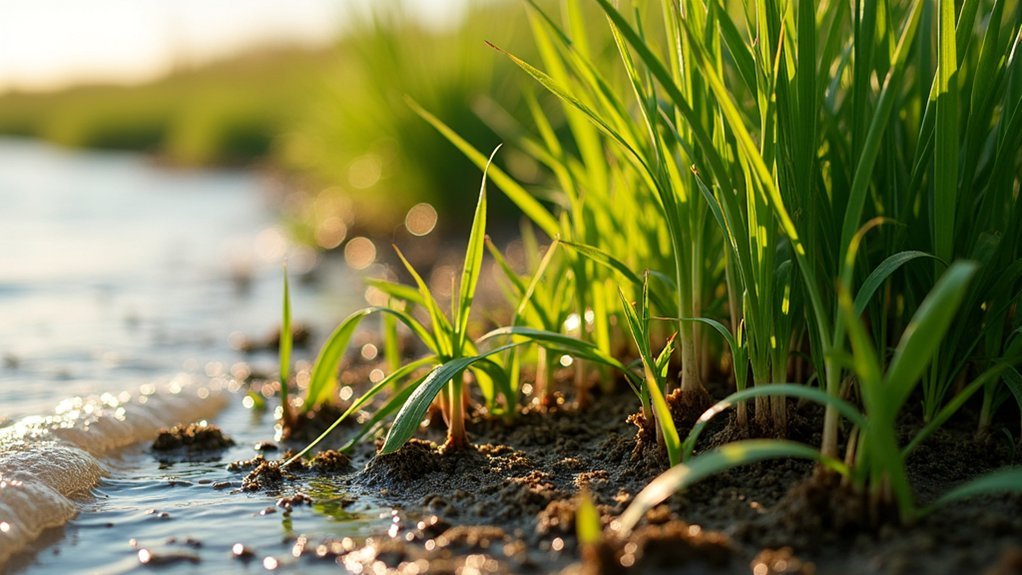For effective wetland erosion control, you’ll want five powerhouse perimeter plants: native sedges and rushes with their soil-gripping fibrous roots; pickerelweed offering beautiful blooms alongside strong rhizomes; arrowhead plants that feed waterfowl while stabilizing shores; red-osier dogwood providing year-round protection with striking red stems; and switchgrass with roots extending 10 feet deep. These plants don’t just prevent soil loss—they enhance biodiversity and water quality while creating visually appealing natural buffers around your wetland areas.
Native Sedges and Rushes: Nature’s Shoreline Guardians

While many landscapers overlook their potential, native sedges and rushes serve as nature’s premier solution for wetland erosion control. Their fibrous root systems create an underground network that excels at stabilizing soil along shorelines where erosion typically occurs.
You’ll find species like Carex microptera and Juncus working tirelessly beneath the surface, gripping soil particles while their above-ground growth absorbs water energy and reduces runoff. These native plants don’t just prevent soil erosion—they enhance the entire ecosystem by providing wildlife habitat and improving water quality.
When you’re designing wetland perimeters, consider bulrushes and common spike-rush for their gentle spreading habits that form natural barriers against flooding while maintaining ecological balance. Their extensive root networks improve soil structure and water retention, making them invaluable allies in erosion prevention.
Pickerelweed: Beautiful Blooms With Strong Root Systems
Gardeners seeking both beauty and function will find pickerelweed (Pontederia cordata) an ideal shoreline solution. This versatile aquatic plant combines violet-blue flower spikes that bloom for months with practical erosion control capabilities.
Standing 3-4 feet tall with 1-2 feet visible above water, pickerelweed creates attractive borders while its extensive underground rhizome network stabilizes shorelines. You’ll appreciate how its strong root systems firmly anchor soil in place, even during water level fluctuations.
Beyond erosion control, pickerelweed tolerates high phosphate levels and creates valuable habitat for wildlife. Fish find shelter among its submerged roots, while pollinators flock to its vibrant blooms from June through November.
For wet areas needing both shoreline protection and visual appeal, pickerelweed delivers impressive performance in shallow water conditions.
Arrowhead Plants: Duck-Friendly Erosion Fighters

When shorelines need protection that also attracts wildlife, arrowhead plants (Sagittaria latifolia) offer a perfect solution. Growing 1-4 feet tall, these wetland natives feature distinctive arrow-shaped leaves that provide excellent erosion control along water edges.
Their robust root systems firmly anchor shoreline soil, even during water level fluctuations. You’ll appreciate how these resilient plants adapt to rich, damp soils or shallow water environments, making them versatile additions to any wetland restoration project.
Arrowhead plants serve as an essential food source for waterfowl, particularly ducks that feed on their underground tubers.
When they bloom with small white flowers in mid-summer, they’ll enhance your wetland’s visual appeal while simultaneously strengthening its banks against erosion.
Red-Osier Dogwood: Year-Round Protection for Wetland Edges
The striking red stems of Red-Osier Dogwood (Cornus stolonifera) offer both visual drama and powerful erosion control for wetland perimeters. This native shrub’s dense suckering habit and extensive root system effectively bind soil along water edges, preventing loss during heavy rainfall.
You’ll appreciate how this versatile plant grows up to 9 feet tall while stabilizing wetland banks with its robust underground network. The Arctic Fire Red variety provides the same erosion control benefits in a more compact form, perfect for smaller landscapes.
Beyond functionality, red-osier dogwood enhances biodiversity by producing spring flowers and berries that attract wildlife.
When you’re planning wetland edge plantings, this dogwood delivers year-round benefits—soil protection during storms and vibrant red stems that brighten winter landscapes.
Switchgrass: Deep-Rooted Prairie Native for Bank Stabilization

Native to North American prairies, Switchgrass (Panicum virgatum) offers exceptional bank stabilization through its impressive root system that can penetrate up to 10 feet deep into soil.
Switchgrass anchors the soil with powerful roots extending 10 feet deep, making it a native erosion-fighting powerhouse.
This resilient perennial grass grows 3-6 feet tall and spreads via dense rhizomes, creating a natural erosion control network that effectively binds soil along wetland margins.
You’ll appreciate Switchgrass’s adaptability to various soil types and moisture conditions, making it suitable for both wetland edges and upland areas within USDA Zones 4-9.
Beyond erosion control, this deep-rooted native enhances your wetland’s biodiversity by providing valuable habitat and food sources for wildlife.
When you’re looking to protect vulnerable shorelines, Switchgrass delivers both functional strength and ecological benefits in one versatile plant.
Frequently Asked Questions
What Are the Best Plants for Erosion Control?
For erosion control, you’ll find Red-Osier Dogwood, Pickerelweed, Swamp Milkweed, Common Spike-Rush, and Cattails most effective. Their extensive root systems and dense growth habits stabilize soil and prevent washouts in vulnerable areas.
What Do You Call Plants That Control Erosion in a Wetland?
Plants that control erosion in a wetland are called “erosion control plants.” You’ll find that native species like bulrushes, cattails, and sedges are excellent examples because they’ve got extensive root systems that effectively stabilize soil.
How Do Wetland Plants Control Erosion Rates?
Wetland plants control erosion through their extensive root systems that bind soil, dense growth that slows water flow, and ability to create natural barriers against wave action. You’ll find they’re remarkably efficient at stabilizing shorelines.
What Is the Best Groundcover for a Steep Slope?
For a steep slope, you’ll find Juniper most effective as it spreads extensively while requiring minimal maintenance. Its robust root system holds soil firmly, and it thrives in various conditions without needing much attention.
In Summary
By planting these five native perimeter species, you’ll create a natural defense system that keeps your wetland intact while supporting local wildlife. They’ll establish deep root networks to hold soil in place during heavy rains and high water events. Whether you’re managing a small pond or protecting a lakeshore, these versatile plants offer both practical erosion control and aesthetic beauty for your waterside landscape.





Leave a Reply